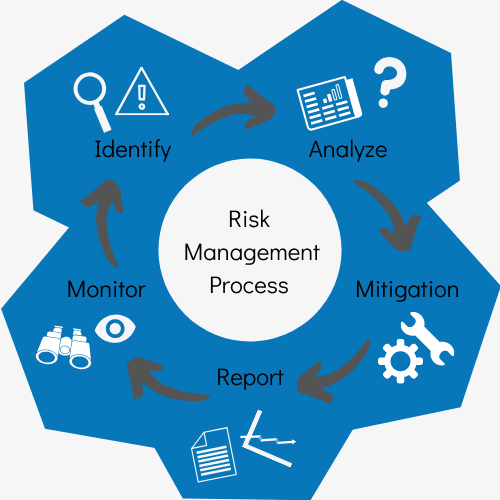How the Importance of Risk Management Shapes Effective Leadership
How the Importance of Risk Management Shapes Effective Leadership
Blog Article
Checking out the Significance of Risk Management for Effective Decision-Making Techniques
In the complex globe of company, Risk Management arises as a crucial element in the decision-making process. The capability to identify possible threats and opportunities, and strategize appropriately, can spell the difference between success and failing. With devices such as SWOT and PESTEL, companies are furnished to make informed selections, fostering durability and flexibility in an ever-changing atmosphere. Wondering exactly how this works? Let's unpack the dynamics additionally.
Comprehending the Idea of Risk Management
Risk Management, a critical element in decision-making, is usually misinterpreted or oversimplified. Generally, it refers to the identification, assessment, and prioritization of dangers to minimize, check, and manage the likelihood or effect of unfortunate events. It's not simply about preventing adverse end results, yet likewise regarding identifying potential chances. Risk Management entails self-displined and organized methods, utilizing information and informative analyses. It needs an extensive understanding of the organization's context, goals, and the prospective dangers that might prevent them. From monetary unpredictabilities, lawful obligations, critical Management mistakes, to crashes and natural disasters, it addresses numerous risks. Notably, efficient Risk Management is not stagnant; it's a continuous, progressive process that evolves with transforming scenarios.
The Duty of Risk Management in Decision-Making Processes
In the world of calculated planning and service operations, Risk Management plays an important role in decision-making processes. It aids in recognizing prospective threats and uncertainties that can impact the achievement of organization purposes. By tracing these dangers, firms can develop techniques to reduce their influence, making sure business connection and security. Risk Management therefore comes to be a crucial tool in decision-making, aiding leaders to make enlightened selections based upon a detailed understanding of the threats included. It urges an aggressive strategy, enabling companies to prepare for and prepare for possible future situations. This dramatically lowers the likelihood of negative consequences, promoting more effective and reliable decision-making techniques. Risk Management serves as an important component in the decision-making processes of any kind of company.

How Risk Management Improves Strategic Planning
In the context of calculated preparation, Risk Management plays an essential duty. Launching with the recognition of possible dangers, it additionally prolongs to the application of Risk mitigation steps. The function of Risk Management is dynamic but not static, as it requires consistent monitoring and adjusting of methods.
Recognizing Possible Threats

Applying Risk Mitigation
Risk reduction strategies can range her latest blog from Risk evasion, Risk transfer, to risk decrease. Each method must be customized to the details Risk, considering its prospective effect and the organization's Risk resistance. Reliable Risk mitigation needs a deep understanding of the Risk landscape and the prospective effect of each Risk.
Tracking and Changing Techniques
Though Risk reduction is a critical action in tactical preparation, continuous tracking and modification of these methods is similarly essential. This recurring procedure allows organizations to recognize new dangers and reassess existing ones, making certain the applied strategies continue to be effective in the ever-changing service setting. It also supplies a possibility to assess the success of the Risk Management measures, enabling modifications to be made where essential, further improving critical planning. Efficient tracking and change call for making use of analytics and essential efficiency indications (KPIs) to measure efficiency. These devices provide important data-driven understandings that can notify critical decision-making. As a result, monitoring and adjusting Risk Management methods is a critical element for boosting a company's resilience and tactical planning.
Instance Researches: Effective Risk Management and Decision-Making
In the globe of company and money, successful Risk Management and decision-making frequently serve as the columns of flourishing business. These cases highlight the worth of astute Risk Management in decision-making procedures. These cases highlight the critical duty of Risk Management in calculated decision-making.
Devices and Techniques for Efficient Risk Management
These devices, such as Risk signs up and heat maps, aid in identifying and evaluating prospective threats. Risk response strategies, an essential component of Risk Management, involve accepting, avoiding, transferring, or mitigating threats. With these strategies and tools, decision-makers can navigate the complicated landscape of Risk Management, thereby helping with educated and reliable decision-making.
Future Fads in Risk Management and Decision-Making Techniques
As we discover the substantial landscape of Risk Management, it ends up being evident that the strategies and devices made use of today will continue to advance. The principle of Risk culture, where every member of a company is conscious and entailed in Risk Management, will obtain more prestige. These patterns declare a more proactive and comprehensive method towards Risk Management and decision-making.
Conclusion

Risk Management therefore comes to be an essential device in decision-making, helping leaders to make educated selections based on a comprehensive understanding of the dangers entailed. Risk reduction approaches can vary from Risk avoidance, Risk transfer, to risk reduction (importance of risk management). Efficient Risk mitigation requires a deep understanding of the Risk landscape and the possible effect of each Risk. Risk response strategies, a key part of Risk Management, involve approving, staying clear of, transferring, or mitigating risks. The principle of Risk culture, where every participant of a company is conscious and involved in Risk Management, will certainly acquire more prominence
Report this page